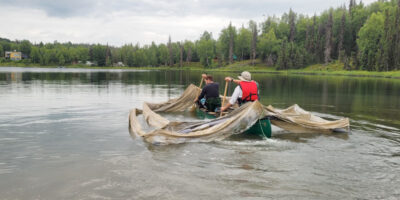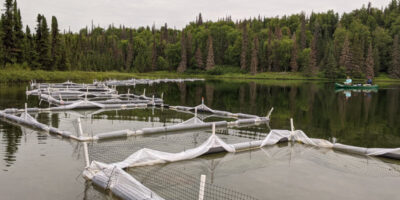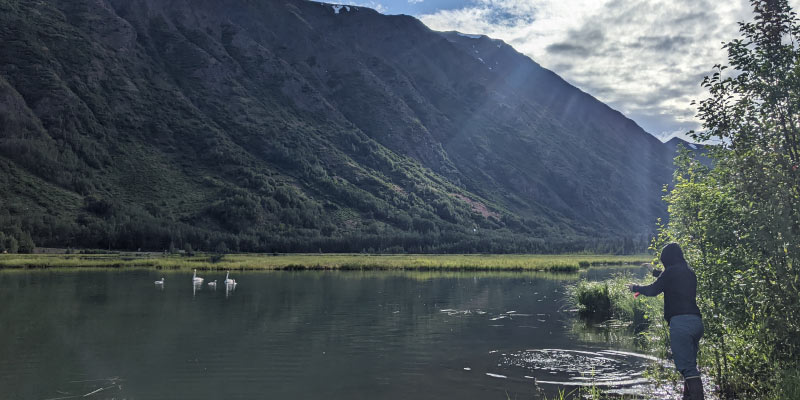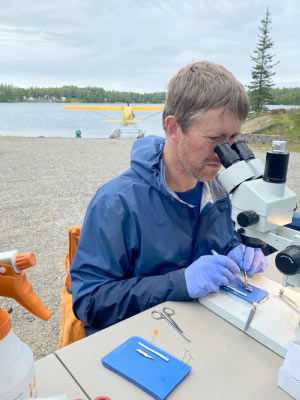
Some Wisconsinites may embark on annual fishing trips, but Jesse Weber’s fishing excursions look a little bit different. Over the past few years, Weber and a team of researchers have traveled up to Alaska’s Kenai Peninsula to study the evolution of threespine stickleback living in nine different experimental lakes. Weber specifically examines how parasites interact with these fish and how the two coevolve within the lakes. Weber was introduced to evolution through researching his own family tree while in elementary school. “The connection between us and all living things is set up so well by trees,” Weber explains. “Later on, I started to wonder how these trees are formed and what they can teach us about evolutionary processes.” His interest in ecology solidified after he participated in a study abroad program in Botswana’s Okavango Delta, where he helped a PhD student with research and, in return, got to observe all sorts of wildlife like wildebeests, hippos, giraffes, and warthogs. “At that point in time, I knew I wanted a career that included field research,” Weber shares.
Weber studied biochemistry and molecular biology at the University of Colorado before earning his PhD in biology from Harvard University. After spending a few years doing postdoctoral research at different universities, Weber accepted his first faculty position at the University of Alaska–Anchorage. In the fall of 2020, Weber came to the University of Wisconsin–Madison’s Department of Integrative Biology as an Assistant Professor and was asked to join the Nelson Institute’s Center for Ecology and the Environment by outgoing director Sean Schoville. He’s currently in charge of the Weber Lab, where he “has his hands in many different pots” of research.
Q: Can you explain the research being done in Alaska?

A: My team is working on what we coined as “the world’s greatest eco-evo experiment” up in Alaska. By “eco-evo,” we mean understanding how ecological interaction affects evolutionary responses, and vice versa. Back in 2019, I worked with collaborators from 10–15 universities around the world to stock nine Alaskan lakes with fish of our choosing. I study a fish called the threespine stickleback. It looks boring on the outside, but is a fascinating animal because we know so much about its ecology compared to most other vertebrates. This fish adapts to many features of its local environments, changing its diet, immune profile, how it grows, and even how it ages. So, we traveled across Alaska to find the most interesting and diverse populations, and then sampled from those populations and combined them into these blank slate lakes. We moved more than 10,000 fish from around the state to the Kenai Peninsula, and now we’re just watching as they evolve — who they mate with, what parasites they get, what they eat, how their morphology changes. Now, we go up to these experimental lakes every summer and catch 100 fish from each one to dissect and further study.
“We have to take advantage of this opportunity so we can learn how to maintain the environment and understand the intricacies of the wonderful ecosystems that we live in.”
Q: What is your role in this project?

A: My work is largely associated with the parasite communities and how those are changing over time. I look at the fish’s parasites and where they’re coming from: are they self-sustaining within the lake, or are birds dumping them in from different lakes? In either case, we look at the parasites and sequence their DNA so we can ask questions about how they’re evolving and where their genetic material is coming from. What’s exciting is that people have studied stickleback for hundreds of years, but every time we go into the field we uncover something brand new that we can further research in the lab. For example, some fish are able to physically shrink the size of tapeworms; they keep the parasite and inhibit them from growing. We also had an exciting publication from last year, when we found that some fish had evolved to tolerate parasites by basically shutting off entire arms of their immune system. Natural selection found that it was most efficient to cope with the worm that’s using up a little bit of their energy and invest their immune resources elsewhere, such as growth and reproduction.
Q: What are you hoping to learn from your research?
A: As the climate is changing, we don’t know how flexible each organism is. Some organisms might be just fine as waters heat up — maybe they have the ability to move to optimal temperatures in a lake, or just to cope with the heat. We’re using these experiments as an opportunity to get a handle on how evolution is working, especially in northern-latitude systems that have a lot of relevance here in Wisconsin.
Q: What’s the importance of coevolution?
A: You can never just think about one system at a time. The interactions between species are so diverse in nature that we need to start thinking about how an evolutionary change in one will lead to an evolutionary change in the other. When it comes to climate change, many people focus on individual species, but we need to get a better feel for how interactions between species are changing as a result of the changing environment. I don’t want to put a silver lining on how rapidly our world is changing, but it’s giving us a chance to study coevolution like never before. We have to take advantage of this opportunity so we can learn how to maintain the environment and understand the intricacies of the wonderful ecosystems that we live in.
Q: What’s it like running the Weber Lab?
A: Busy! You have to learn to manage a lot of things when running a lab. More than anything else, though, the lab is my opportunity to share ideas with students and staff and try to excite them about doing projects. Going into science, I thought I would spend the most time at the bench or in the field collecting data, but my team is doing most of that work. I keep track of everything, make sure they’re going in the right direction, and acquire funding to keep things running, but it’s still exciting because I get to have my hands in so many different experimental pots. I get to participate in field research, breeding experiments in the lab, infection experiments, and even things like measuring how much energy is expended by mitochondria. I kind of feel like I’m the director behind the curtains of a play.

Q: What is your favorite part of your job?
A: Selfishly, it’s the traveling! As a scientist, and specifically as an evolutionary biologist that’s not wedded to studying a single organism, I can pick the things that are most interesting to me and go around the world to study them. Whether that be going to places like Alaska and Canada, but also as far afield as Iceland or other places in Europe. I can go wherever interesting questions take me.
Q: Do you have any research goals for the future?

A: One thing that we really want to continue doing is finding mutations in particular genes that cause interesting trait variations. For example, what genetic change allows a fish to tolerate a tapeworm. In the big picture, we want to find out how diverse these genetic changes are in nature, and which mutations are most successful. With this, we might even be able to predict where evolution will go.
Q: Are there any misconceptions about your field or research?
A: People should know that parasites aren’t always bad! There’s this thing called the “old friends” hypothesis, which basically says that, historically, parasites have been so common in systems that they’ve become integral to these systems. People are no exception. Until recently, when modern medicine rid us of our parasites, we had evolved ways to cope with them. Our immune response was altered to expect that we’d have parasites in us, and those parasites also expressed different things to manipulate us. It was almost like a détente in military context, where these two systems came together and found a sort of equilibrium. If you remove the parasites, you have an immense immune response that isn’t being regulated, and that’s going to hurt you. The rise in autoimmune diseases and things like allergies are probably associated with a lack of parasites in systems. If we can find ways to understand how parasites are living in us, we might be able to create synthetic things that mimic those parasites. Through this, we might be able to cure an awful lot of disease — but it all comes from an understanding that parasites used to naturally exist in us and we’ve evolved to deal with them.
Q: Can students become involved with your research?
A: Students can be involved in any part of these projects! The easiest way to get involved is just reaching out. I recommend that if a student is interested in a project or lab, they should try to read a few relevant publications first and then write to the professor if they’re still interested. There are tons of opportunities — from paid fellowships to volunteering — that are open. In my lab, students can become involved in animal husbandry, DNA sequencing, parasite screens and dissections, and even field work. These are all really great opportunities and we’re excited to have students participate.
Q: Is there anything you want our readers to know?
A: I want to plant a seed that there are tremendous opportunities for the public to get involved with the kinds of research that we do. Since moving here, I’ve been enamored with how much Wisconsinites love their lakes and love spending time in and around them. When people catch and filet fish, I want to know what they’re finding! Did you find something interesting inside of a fish? If so, tell me about it! Better yet, send it to me! I want to talk to the public more about what they’re finding and help them understand what they’re seeing out there, especially in the context of these economically and ecologically important topics like lakes and fisheries.